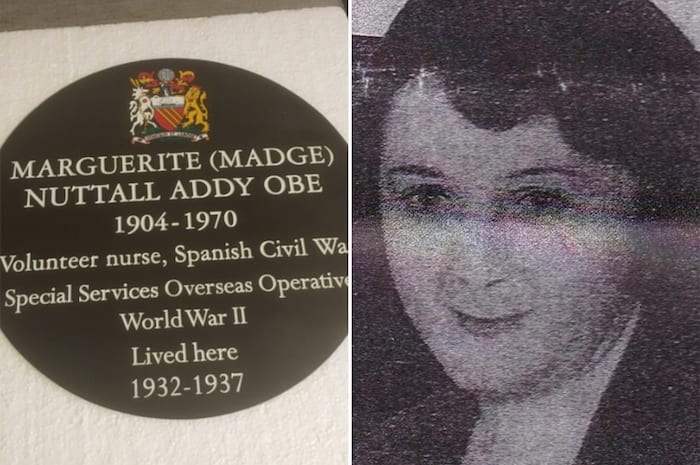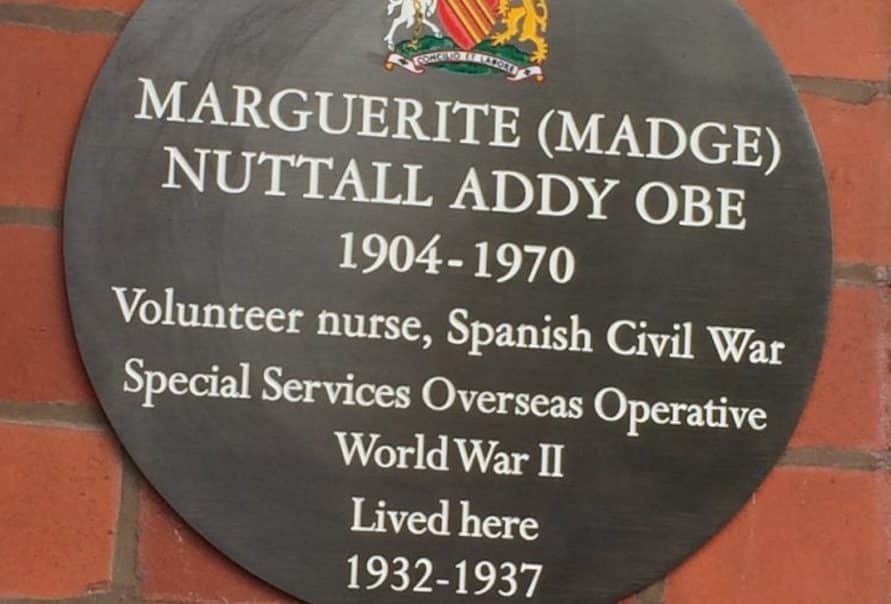The incredible story of a Manchester nurse turned international spy
- Written by Thom Bamford
- Last updated 46 seconds ago
- City of Manchester, Cornerstone, Featured, History

Manchester has produced many remarkable figures, but few stories are as extraordinary as Madge Addy’s.
From a working-class upbringing in Rusholme to the battlefields of the Spanish Civil War and the secret corridors of wartime espionage, her life reads like the script of a Hollywood thriller.
A nurse, a resistance fighter, and a secret agent, Madge’s courage and determination saw her play a vital role in both the Spanish Civil War and World War II. Today, her name is etched into Manchester’s history, recognised with a blue plaque on Manchester Road in Chorlton.
Madge Addy

Born Marguerite Nuttall Addy in February 1904, Madge was the sixth of seven children.
Her father, Frederick William Addy, was a reed maker who passed away before she turned ten, leaving her mother, Mary, to raise the family alone. Known locally as ‘Red Mary’ for her left-wing views, Madge’s mother instilled in her a strong sense of independence and political awareness—values that would shape the rest of her life.
Madge led a relatively conventional life through her twenties. In 1930, she married her next-door neighbour, Arthur Lightfoot, and the couple set up a chiropody practice together. However, her marriage was reportedly strained, and by the mid-1930s, she was ready for change. That change came in the form of the Spanish Civil War.
Madge at the Spanish Civil War
When the Spanish Civil War broke out in July 1936, volunteers from Manchester and beyond travelled to Spain to fight for the Republican cause or serve as medical personnel. Moved by both political and humanitarian concerns, Madge made the life-altering decision to leave Manchester and join the International Brigades, a group of volunteers fighting against Franco’s fascist forces.
Her journey to Spain was far from easy. After applying to the Spanish Medical Aid Committee (SMAC), she travelled to London for an interview before making her way to the war-torn country.
Arriving in the summer of 1937, she was stationed on the Aragón front, later working at Uclés Hospital in central Spain, which was housed in a former monastery. Conditions were dire: patients were covered in lice, lacked clean clothes, and went weeks without being washed due to shortages of towels and bowls. Despite these challenges, Madge and her fellow nurses worked tirelessly, tending to soldiers wounded on the battlefield.
It was during her time at Uclés that Madge met Wilhelm Holst, a married Norwegian volunteer with whom she began a passionate relationship. However, her time in Spain came to an abrupt end in 1939 when the hospital was captured by Franco’s forces.
She was held for weeks before being released and allowed to return to Britain, but her days of adventure were far from over.
A new war, a new mission
After a brief return home, Madge reunited with Holst in Paris, where she helped provide relief for Spanish Republicans who had fled Franco’s victory. But with the outbreak of World War II and the Nazi occupation of France, she once again found herself drawn into resistance work.
Unlike many secret agents, Madge was not recruited by British intelligence back in London—her journey into espionage began on the ground in occupied France. By 1940, she was aiding British soldiers and officers in escaping from Marseille, working alongside figures like Ian Garrow and Nancy Wake, later one of the most decorated female SOE (Special Operations Executive) operatives of the war.
Madge’s role in the resistance evolved quickly. She became a courier, delivering secret messages and transporting funds across enemy lines, sometimes posing as a wealthy Norwegian woman travelling for health reasons. She learned how to use secret inks and carried intelligence sewn into the lining of her coat. She housed agents in her home, managed secret correspondence, and answered phones, all while under constant threat of arrest.
Her most significant contribution was her role in setting up escape lines for Allied agents and servicemen. She played a key part in the famous Garrow-O’Leary line, which helped Allied airmen and agents flee to Spain, as well as the Pierre-Jacques line, an SOE operation that rescued agents in trouble. She worked alongside key figures in the resistance, including Albert Guernisse, also known as Pat O’Leary.
Rising through the ranks
Madge’s bravery and resourcefulness did not go unnoticed. She became second-in-command of the Billet and Alexandre SOE networks, eventually taking over leadership when Holst fell ill. As a full-time paid agent with the rank of lieutenant, she had links with British intelligence agencies MI9 and SIS, as well as the French Resistance. Her aliases included ‘Mrs Oats’ and ‘Billette,’ and she took on increasingly dangerous missions.
For four years, she worked against the Vichy regime and the German occupiers, later remarking, “I believe in taking the war into the enemy’s camp.” Her wartime service ended in September 1944, when the networks she was involved with were shut down following the liberation of France.
Winning the Order of the British Empire
For her extraordinary service, Madge was awarded the Order of the British Empire (OBE) in 1946 and the French Croix de Guerre, one of France’s highest military honours.
After the war, she briefly returned to Manchester before settling in France with her new partner, Thorkild Hansen, a Danish agent she had met during the war. They eventually relocated to London, where they married in 1955.
Despite her remarkable life, Madge’s story faded into obscurity after the war. She lived quietly in London until her death in 1970 at the age of 66. Though her final years were unremarkable, her wartime heroics remain a testament to her extraordinary courage.
Remembering Madge Addy’s story

For decades, Madge Addy’s story was largely forgotten, but in May 2018, her legacy was finally honoured with a blue plaque on Manchester Road in Chorlton, where she had lived and worked as a hairdresser before her departure for Spain.
Her story, recounted in Chris Hall’s book The Nurse Who Became a Spy, offers a thrilling account of how an ‘ordinary’ woman from Manchester became a key figure in two of the 20th century’s most significant conflicts. Whether tending to wounded soldiers on the battlefields of Spain or outwitting the Nazis in occupied France, Madge Addy’s bravery and commitment to justice made her one of Manchester’s most remarkable figures.
Her life is a reminder that heroes don’t always wear uniforms or wield weapons—sometimes, they come in the form of a nurse with a fierce sense of justice and an unshakable determination to make a difference.
Manchester should be proud to call Madge Addy one of its own.
- This article was last updated 46 seconds ago.
- It was first published on 18 February 2025 and is subject to be updated from time to time. Please refresh or return to see the latest version.
Did we miss something? Let us know: [email protected]
Want to be the first to receive all the latest news stories, what’s on and events from the heart of Manchester? Sign up here.
Manchester is a successful city, but many people suffer. I Love Manchester helps raise awareness and funds to help improve the lives and prospects of people across Greater Manchester – and we can’t do it without your help. So please support us with what you can so we can continue to spread the love. Thank you in advance!
An email you’ll love. Subscribe to our newsletter to get the latest news stories delivered direct to your inbox.
Got a story worth sharing?
What’s the story? We are all ears when it comes to positive news and inspiring stories. You can send story ideas to [email protected]
While we can’t guarantee to publish everything, we will always consider any enquiry or idea that promotes:
- Independent new openings
- Human interest
- Not-for-profit organisations
- Community Interest Companies (CiCs) and projects
- Charities and charitable initiatives
- Affordability and offers saving people over 20%
For anything else, don’t hesitate to get in touch with us about advertorials (from £350+VAT) and advertising opportunities: [email protected]

Piccadilly’s forgotten railway arches in line for £1.7 billion renovation

“There is a great buzz around the city, we love it” Snooker legend chats ahead of Tour Championship’s return

Hydration, motivation, and celebration: how to get ready for the Great Manchester Run


















